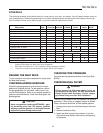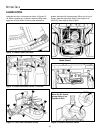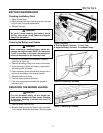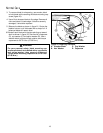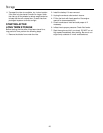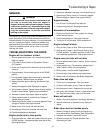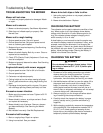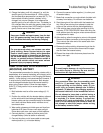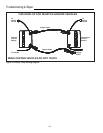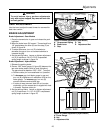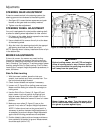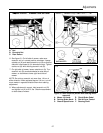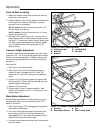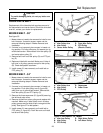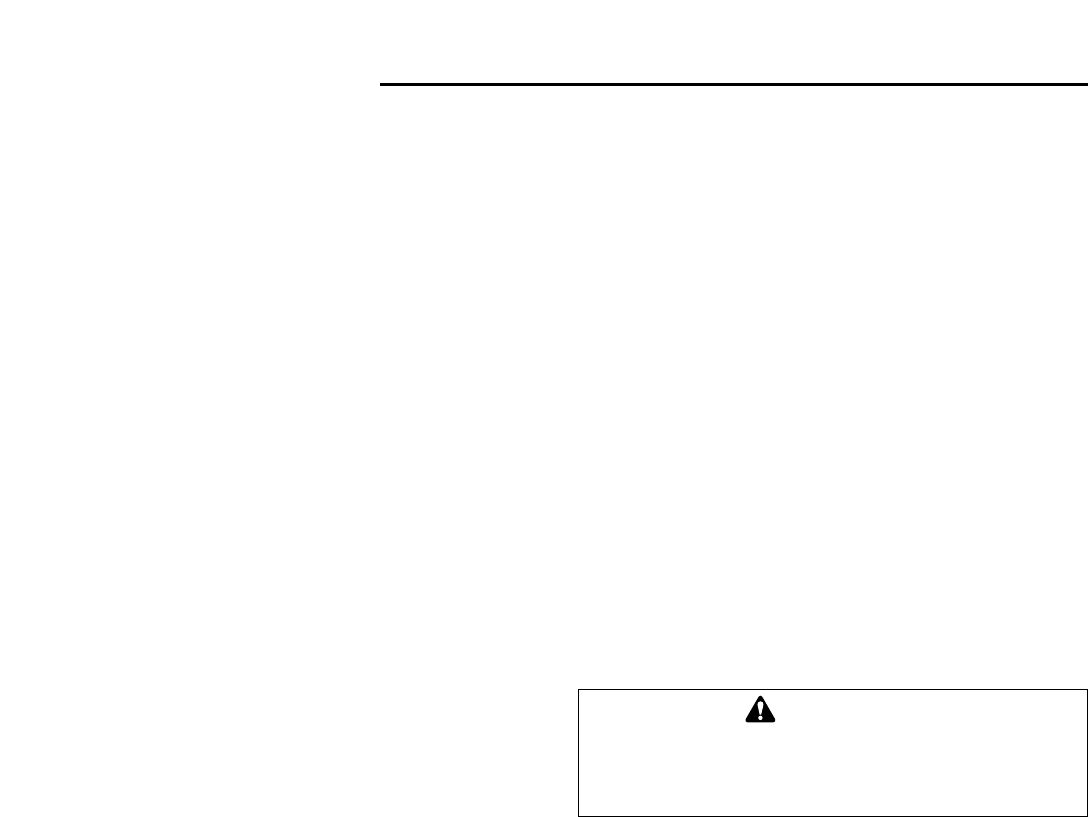
22
TROUBLESHOOTING THE MOWER
Mower will not raise.
1. Lift cable not properly attached or damaged. Attach
or repair.
Mower cut is uneven.
1. Mower not leveled properly. See Mower Adjustment.
2. Rider tires not inflated equally or properly. See
Normal Care.
Mower cut is rough looking.
1. Engine speed too slow. Set to full speed.
2. Ground speed too fast. Set ground speed control
lever at a slower ground speed.
3. Blades dull and require sharpening. See Servicing
the Mower Blades.
4. Mower drive belt slipping. Belt oily or worn. Clean or
replace belt as necessary.
5. Check PTO (Electric Clutch) Adjustment. Clutch may
need to be adjusted.
6. Blades not properly fastened to arbors. See Servicing
the Mower Blades.
Engine stalls easily with mower engaged.
1. Engine speed too slow. Set for 3/4 to full throttle.
2. Ground speed too fast.
3. Carburetor not adjusted properly.
4. Cutting height set too low when mowing tall grass.
Cut tall grass at maximum cutting height during first
pass.
5. Discharge chute jamming with cut grass. Cut grass
with discharge pointing toward previously cut area.
Excessive mower vibration.
1. Blade mounting screws are loose. Tighten to 50-70
ft.lbs. (67-95 N.m.).
2. Mower blade(s), arbors, or pulleys are bent. Check
and replace as necessary.
3. Mower blade(s) out of balance. Remove, sharpen
and balance blade(s). See Servicing the Mower
Blade(s).
4. Belt installed incorrectly. See Belt Replacement.
Excessive belt breakage.
1. Bent or rough pulleys. Repair or replace.
2. Using incorrect belt. See your dealer.
Mower drive belt slips or fails to drive.
1. Idler pulley spring broken or not properly attached.
See your dealer.
2. Mower drive belt broken. Replace.
CHECKING THE BATTERY
The voltmeter can be used to determine condition of bat-
tery. When engine is off, the voltmeter shows battery
voltage, which should be 12 volts. When engine is run-
ning, the voltmeter shows voltage of charging circuit
which normally is 13 to 14 volts.
A dead battery or one too weak to start the engine may
not mean the battery needs to be replaced. It may, as an
example, mean that the alternator is not charging the
battery properly. If there is any doubt about the cause of
the problem, see your dealer. If you need to replace the
battery, follow the steps under Cleaning the Battery &
Cables in the Normal Care Section.
CHARGING THE BATTERY
1. Be aware of all the safety precautions you should
observe during the charging operation. If you are
unfamiliar with the use of a battery charger and
hydrometer, have the battery serviced by your dealer.
2. Add distilled water sufficient to cover the plates (fill to
the proper level near the end of the charge). If the
battery is extremely cold, allow it to warm before
adding water because the water level will rise as it
warms. Also, an extremely cold battery will not accept
a normal charge until it becomes warm.
3. Always unplug or turn the charger off before attach-
ing or removing the clamp connections.
4. Carefully attach the clamps to the battery in proper
polarity (usually red to [+] positive and black to [-]
negative).
5. While charging, periodically measure the temperature
of the electrolyte. If the temperature exceeds 125° F
(51.6° C), or if violent gassing or spewing of elec-
trolyte occurs, the charging rate must be reduced or
temporarily halted to prevent battery damage.
Troubleshooting & Repair
WARNING
Do not attempt to charge a frozen battery. Allow
the battery to warm to 60° F (15.5° C) before plac-
ing on charge.




